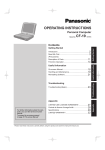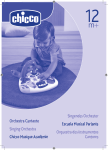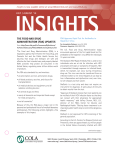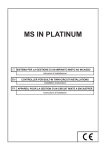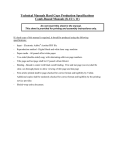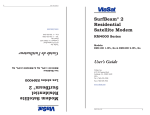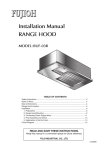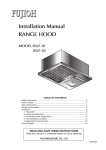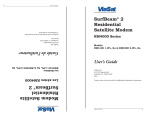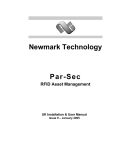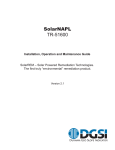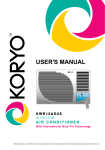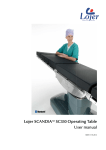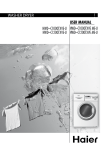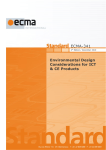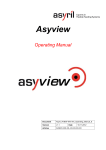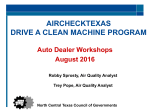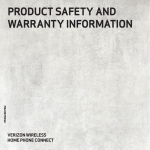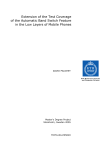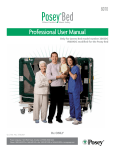Download Design for Environment Checklist for Electronics
Transcript
Annex A (informative) Design Guidance and Design for Environm ent Checklist Designing a product for optimum environmental performance requiresthecareful consideration of a number of different environmental aspects along with other product criteria such as functional performance,longterm reliability, safety, and cost competitiveness. Inmanyinstances, the designer must evaluate complex tradeoffs among these various criteria to provide a productthat is both useful to consumers and protective of the environment. This informative Annex provides a checklist of both environmental requirements and recommendations derived from Clauses 6 and 7 of this Standard. The purpose of this checklist is to assist designers in the consideration of environmental aspectsoftheirdesignand to help document, in a Design for Environment Checklist, the specific environmental design attributes that were incorporatedinto a given electrical and electronic product. It is important to recognize that few products will be able to incorporate all of the design attributes discussed in this Annex, or even included in a manufacturer’s own design checklist. Due to the large numberofdifferent types of electrical and electronic equipment and their varying design characteristics, it is not possible to develop a single checklist that will be appropriate for all products. Consequently, manufacturers should develop checklists appropriate to their particular product types providingonlythose environmental characteristics applicable to their product(s). For this reason, this checklist is offered primarily as a template. A.0 General Considerations Life Cycle thinking design strategy implemented in the organisation ( ) Yes ( ) No A.1 Material efficiency The variety of materials used in the product has been reduced. ( ) Yes, describe briefly ________________________________________________ ( ) No The amount of material used in the product has been reduced. ( ) Yes, describe briefly ________________________________________________ ( ) No The product contains materials that are considered to have lower environmental impact. ( ) Yes, describe briefly ________________________________________________ ( ) No The product contains recycled materials. ( ) Yes ( ) No - 15 - The product uses renewable materials. ( ) Yes describe briefly ________________________________________________ ( ) No A.2 Energyefficiency A.2.1 Power modes and related energy efficiency measures Ease of use as related to the selection and operation ofpower saving features was considered and implemented. ( ) Yes,considered and implemented; describe briefly:_________________________________________________________________ ( )Yes, considered but not implemented; specify reason(s):________________________________________________________________ ( ) Not applicable ( ) No List specific power modes that apply to the product. Detail significant power consumption modules and plans to reduce their consumption. A.2.2 Operational Modes Note actions taken to use low power components and design options. Note actions taken to improve the energy efficiency of power supply components. Note actions taken to ensure the AC-DC conversion efficiency is highest in the most used power mode. Note actions taken to ensure overspecification of items such as the power supply has not taken place. - 16 - Detail analysis undertaken to ensure operating characteristicssuch asroom temperature have not been over specified. A.2.3 Energy Saving Modes Note design actions taken to automatically switch from on mode to save modes. Note design actions taken to reduce the time taken for the product to switch from save mode to active mode. List actions taken to reduce energyconsumption in save mode similar to those taken in A.2.2 above. A.2.4 Off Modes Note design options taken to automatically switch from save mode to off mode. Note design options taken to reduce energy consumption in soft off mode. Note options considered in the placing of the power switch to make it more user accessible. In Hard-Off mode, is the power consumed zero Watts? ( ) Yes ( ) No. If no, what actions have been taken to inform the user of this? A.2.5 No Load Modes Listdesign options taken to reduce the power consumption of the no load mode to the lowest possible. - 17 - A.2.6 General Energy Efficiency measures List any power saving features of this product here that have not been noted elsewhere. Informationon power consumption in all relevant power modes has been made available to product users. ( ) Yes, list sources [ ] Manufacturer Environmental Product Declaration [ ] Product Specification Document [ ] Product User Manual (Hard Copy) [ ] Product User Manual (Soft Copy) [ ] Product Labels or Packaging [ ] Product Packaging Insert [ ] Internet. Provide URL ________________________________________________ [ ] Other. Describe. _______________________________________________________ ( ) Not applicable ( ) No Applicable voluntary agreements aimed at improving energy efficiency ofEEE products were considered and recommendations met. ( ) Yes, considered and recommendations met; describe briefly: ____________________________________________________________________ ( ) Yes, considered but recommendations not met; specify reason(s):____________________________________________________________________ ( ) Not applicable ( ) No The product is compliant to the requirements of the international ENERGY STAR ® program. ( ) Yes, according version ________________________ ( ) Not applicable ( ) No; give reason(s) for non-compliance. ________________________________________________ _______________________________________________________________________________ The effects of improved energy design features have been quantified and communicated to marketing. ( ) Yes ( ) No/Not applicable - 18 - Default setting is set to the most energy efficient on modes and/or transitions to save mode. ( ) Yes ( ) No Informationonproperuse of available energy saving controls and/or settings is available to product users. ( ) Yes, list sources [ ] Product User Manual (Hard Copy) [ ] Product User Manual (Soft Copy) [ ] Product or Packaging Labels [ ] Product Packaging Insert [ ] Internet.Provide URL. ___________________________________________________ [ ] Other. Describe. _________________________________________________________ ( ) Not Applicable ( ) No A.3 Consumables and batteries A.3.1 Consumables The avoidance of hazardous substances and preparations in consumables has been considered. ( ) Yes ( ) Not Applicable (no consumables) ( ) No The product has been designed such that the use of consumables associated with the product can be optimised relative to the functionality of the product. ( ) Yes ( ) Not Applicable (no consumables) ( ) No Information on the proper use ofconsumablesassociated with the product has been provided to the user. ( ) Yes, list sources (all that apply): [ ] Manufacturer Environmental Product Declaration [ ] Product User Manual (Hard Copy) [ ] Product User Manual (Soft Copy) [ ] Product Service Manual [ ] Internet. Provide URL. ___________________________________________________________ [ ] Other. Describe. ________________________________________________________________ ( ) Not Applicable (No consumables) ( ) No - 19 - A.3.2 Batteries Allbatteries in the product comply with applicable restrictions on hazardous substances and preparations contained in relevant national, regional and international legislation. ( ) Yes ( ) Not Applicable (no batteries) ( ) No All batteries in the product are labelled according to requirements of relevantregional, national or international legislation. ( ) Yes ( ) Not Applicable (no batteries) ( ) No All batteries do not exceed a mercury concentration of 5 ppm by weight. ( ) Yes ( ) No. If no provide reason(s) why mercury cannot be avoided: __________________________________ _____________________________________________________________________________ Consideration has been given to batteries with reduced environmental impact. ( ) Yes; specify type of batteries considered (check all that apply). [ ] Li-Ion [ ] Li-Polymer [ ] NiMH [ ] Other; describe _________________________________________________________________ ( ) Not Applicable (no batteries) ( ) No; specify reason(s) ______________________________________________________________ The product has batteries containing materials regardedas detrimental to the environment that cannot be avoided. ( ) No ( ) Not Applicable (no batteries) ( ) Yes [ ] Identify batteries ______________________________________________________________ [ ] Where reported _______________________________________________________________ [ ] Reason(s) why material(s) cannot be avoided _________________________________________ ___________________________________________________________________________ - 20 - All batteries and assemblies containing batteries are easily identifiable and removable. ( ) Yes ( ) Not Applicable (no batteries) ( ) No; specify reason(s): [ ]batteries are not intended to be removeduntil the end of life stage and equipment reliant on continuous power supply / no special disposal requirement [ ]other _______________________________________________________________________ Information on proper procedures for removal and safe handling of batteries isavailablein product user documentation. ( ) Yes, list sources [ ] Manufacturer Environmental Product Declaration [ ] Product User Manual (Hard Copy) [ ] Product User Manual (Soft Copy) [ ] Product Service Manual [ ] Product Labels [ ] Internet. Provide URL ____________________________________________________________ [ ] Other: describe. _________________________________________________________________ ( ) Not Applicable (no batteries) ( ) No; give reason(s) _________________________________________________________________ For NOT easily removable batteries: Advice on service outlets for exchange of nonremovable batteries (during product life) is provided in the product documentation. ( ) Yes ( ) Not Applicable (no batteries and/or accumulators) ( ) No Information on type and location is available in the appropriate product documentation. ( ) Yes [ ]type of battery ________________________________________________________________ [ ] location _____________________________________________________________________ ( ) Not Applicable (no non-removable batteries) ( ) No - 21 - Battery managementfeatures thathelp to prolong battery and/or accumulator life have been considered and implemented. ( ) Yes, considered and implemented ( ) Yes, considered but not implemented ( ) Not Applicable (no batteries) ( ) No; give reason(s) __________________________________________________________ A.4 Emissions A.4.1 Chemical Emissions Product has been designed such that chemical emissions are reduced wherever possible. ( ) Yes ( ) Not Applicable (product is not based on electrostatic process) ( ) No Product complies with all relevant regulations governing chemical emissions from products. ( ) Yes ( ) Not Applicable (product does not consume supplies) ( ) No ( ) No relevant regulations available For a product based on the electrostatic process, chemical emissions (Ozone and VOC) and dust emissions have been evaluated. ( ) Yes ( ) Not Applicable (product is not based on electrostatic process) ( ) No Fora product based on the electrostatic process, emissions measurements have been completed in accordance with Standard ECMA-328. ( ) Yes ( ) Not Applicable (product does not consume supplies) ( ) No Results of the emissions measurement(s) have been made available to product users. ( ) Yes, list sources [ ] Manufacturer Environmental Product Declaration [ ] Product User Manual (Hard Copy) [ ] Product User Manual (Soft Copy) [ ] Product Service Manual [ ] Internet. Provide URL ______________________________________________________________ [ ] Other: describe. ___________________________________________________________________ ( ) Not Applicable (product does not consume supplies) ( ) No; give reason(s) _________________________________________________________________ - 22 - A.4.2 Noise Emissions Noise emissions have been evaluated according to ECMA-74. ( ) Yes ( ) No ( ) Other – describe ( ) Not applicable For products outside the scope of ECMA-74, ISO 3741, 3744 or 3745 has been used. ( ) Yes ( ) No ( ) Not applicable Results of noise emissions measurement are available. ( ) Yes ( ) No ( ) Not applicable A.5 Extension of Product Lifetime The product contains common mechanical packages (such as covers and chassis) or common partsorcomponentsthat are used for multiple models in the product family or in multiple generations of the same product. ( ) Yes, describe. _______________________________________________________________________ ( ) Not applicable ( ) No The product contains industry standard parts. ( ) Yes, list ___________________________________________________________________________ ( ) No ( ) Not applicable The product contains modular components. ( ) Yes, list. ___________________________________________________________________________ ( ) Not applicable ( ) No The product contains reused components and/or parts. ( ) Yes, list. ___________________________________________________________________________ ( ) Not applicable ( ) No - 23 - The product contains parts targeted for refurbishment and reuse in maintenance and spare parts applications. ( ) Yes, list. ___________________________________________________________________________ ( ) Not applicable ( ) No A.6 End of Life Separation of parts containing hazardous substances and preparations is possible. ( ) Yes ( ) No ( ) Not applicable Incompatible materials (including electronic modules)connected to case/housing parts or chassis are easily separable. ( ) Yes ( ) No ( ) Not applicable The productcan be disassembled down to the module level using commonly available tools. ( ) Yes ( ) No, list all special tools required for disassembly. _______________________________________________________________________________ _______________________________________________________________________________ Allplastic parts with weight greater than 25 g are marked with the type of polymer, copolymer, polymer blends or alloys in conformance with ISO 11469. ( ) Yes ( ) No ( ) Not applicable The following design choices have been avoided. ( ( ( ( ) Incompatible coatings on major plastic parts ) Coatings and surface finishes on plastic parts that are difficult to recycle without downgrading ) Adhesive backed stickers or foams on plastic parts ) Metal inserts in plastic parts The following aspects have been considered and their number and variety reduced. ( ) Welds and Adhesives ( ) Connections (e.g. Fasteners and screws) ( ) Steps necessary for disassembly ( ) tools required for disassembly ( ) position changes that have to be made by the dismantler - 24 - The following design choices have been included. ( ) the same polymer is used throughout the design of a product. If this is not practical, the number of plastic types used in the product has been reduced ( ) Yes ( ) No The compatibility guidelines found in Annex C has been used in selecting polymers ( ) Yes ( ) No ( ) The product has been designed such that modules can be extracted for reuse ( ) Labels and other identification marks are made from the same material as the body of the products or a compatible material ( ) Snap fits or screws are used to aid disassembly A plan for the disassembly of the product into major modules or sub assemblies has been created and made available to dismantlers. ( ) Yes ( ) No A.7 Substances and preparations needing special attention A.7.0 Content in products The productcomplies with the applicable international, regional and national prohibitions on the use of certain hazardous substances and preparations. ( ) Yes, list _________________________________________________________________________ ( ) Not applicable ( ) No Use of substances that require special handling or disposal during the recycling process has been reduced or eliminated. ( ) Yes, eliminated; ( ) Yes, reduced; list __________________________________________________________________ ( ) Not applicable ( ) No - 25 - Appropriate information on parts requiring special handling or disposal has been made available to users and recyclers. ( ) Yes ( ) No ( ) Not applicable Hazardous substances other than those restricted are used in this product. ( ) Yes – List the substances and give rationale for their use ( ) No A.7.1 General limitations The product does NOT/ does contain the following substances. ( ) Does not contain ( ) Does contain Asbestos ( ) Does not contain ( ) Does contain Ozone Depleting Substances: Chlorofluorocarbons (CFC), hydrobromofluorocarbons (HBFC), hydrochlorofluorcarbons (HCFC), Halons, carbontetrachloride, 1,1,1-trichloroethane, bromochloromethane ( ) Does not contain ( ) Does contain PCB, PCT, monomethyltetrachlorodiphenylmethane (Ugilec 141), monomethyldichlorodiphenylmethane (Ugilec 121 or 21), monomethyldibromodiphenylmethane (DBBT) ( ) Does not contain ( ) Does contain PCN ( ) Does not contain ( ) Does contain tin organic compounds: TPT, TBT,TBTO, DBB ( ) Does not contain ( ) Does contain PentaBDE, OctaBDE ( ) Does not contain ( ) Does contain PCN ( ) Does not contain ( ) Does contain Mercury (exception: discharge lamps) Additional from July 2006 (except exemptions made in RoHS Directive): ( ) Does not contain ( ) Does contain Lead ( ) Does not contain ( ) Does contain Cadmium ( ) Does not contain ( ) Does contain Hexavalent chromium ( ) Does not contain ( ) Does contain PBB, PBDE Substances recorded to be restricted in the clauses above are present in the product. ( ) No ( ) Yes; provide reason(s) why material(s) cannot be avoided:__________________________________ _____________________________________________________________________________ - 26 - A.7.2 Limitations on plastic parts, mechanical parts and housings The plastic parts for the product do NOT/ do contain the following substances. ( ) Do not contain ( ) Do not contain ( ) Do not contain ( ) Do contain ( ) Do contain ( ) Do contain Cadmium or cadmium compounds Short chain chloroparaffins Lead or lead compounds Substances recorded to be restricted in the clauses above are present in the product. ( ) No ( ) Yes; provide reason(s) why material(s) cannot be avoided:__________________________________ _____________________________________________________________________________ A.7.3 Limitations on paints, coatings or colouring agents The paints, coatings or colouring agents for the product do NOT / do contain the following substances. ( ) Do not contain ( ) Do not contain ( ) Do contain ( ) Do contain Cadmium or cadmium compounds Lead or lead compounds Substances recorded to be restricted in the clauses above are present in the product. ( ) No ( ) Yes; provide reason(s) why material(s) cannot be avoided:__________________________________ _____________________________________________________________________________ A.7.4 Limitations on other parts/products Textiles and leather coming into direct contact with the skin do NOT /do contain the following substances. ( ) Do not contain ( ) Do contain ( ) Do not contain ( ) Do contain specified in 76/769/EEC (2003/3/EC) ( ) Do not contain ( ) Do contain TRIS, TEPA, PBB AZO colourants that split aromatic amines Hexavalent chromium Wood parts/products do NOT / do contain the following substances. ( ) Do not contain ( ) Do not contain ( ) Do not contain ( ) Do contain ( ) Do contain ( ) Do contain Arsenic as a wood preservation treatment Mercury for preservation of wood Pentachlorophenol and derivatives Toys do NOT / do contain the following substances. ( ) Do not contain ( ) Do contain Benzene Articles coming into direct and prolonged contact with the skin do NOT / do contain the following substances. ( ) Do not contain ( ) Do contain - 27 - Nickel Substances recorded to be restricted in the clauses above are present in the product. ( ) No ( ) Yes; provide reason(s) why material(s) cannot be avoided:__________________________________ _____________________________________________________________________________ A.8 Packaging The variety of packaging materials used has been reduced. ( ) Yes, describe briefly ________________________________________________ ( ) No The amount of packaging materials used has been reduced. ( ) Yes, describe briefly ________________________________________________ ( ) No The used packaging materials are considered to have lower environmental impact. ( ) Yes, describe briefly ________________________________________________ ( ) No The packaging was manufactured using recycled materials. ( ) Yes ( ) No The packaging was manufactured using renewable materials. ( ) Yes describe briefly ________________________________________________ ( ) No The packaging complies with the applicable international, regional and national regulations. ( ) Yes, list _________________________________________________________________________ ( ) No The packaging materials have an appropriate marking (e.g. according to ISO 11469). ( ) Yes, list applied standard _________________________________________________________________________ ( ) No provide reason(s) why packaging material(s) cannot be marked:___________________________ - 28 - A.9 Documentation Instructions forconsumers/users on how to install, use, maintain and, where applicable, dispose of the product is provided – especially as it pertains to the environmental characteristics of the product. ( ) Yes, list sources [ ] Product Specification Document [ ] Manufacturer Environmental Product Declaration [ ] Product User Manual (Hard Copy) [ ] Product User Manual (Soft Copy) [ ] Product Labels or Packaging [ ] Product Packaging Insert [ ] Internet. Provide URL.____________________________________________________________ [ ] Other. Describe._________________________________________________________________ ( ) No Allapplicable productenvironmental information to be made available to product users is provided according to ECMA TR/70. ( ) Yes ( ) No - 29 -















